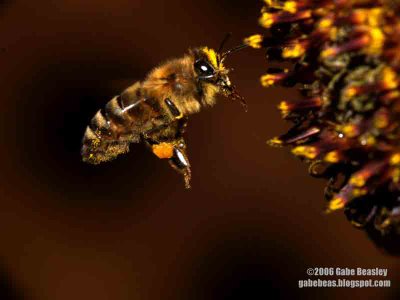
"Highlight"
A honey bee, in flight. This is just be beginning of a series and sequences of shots I have been taking this summer. Sorry about the long wait! I have had to completely re-do my file system and backup literally 100s of CDs. All this work and way to many pictures caused me to switch to RAW, which has given me new abilities and new knowledge. Someday I wish to be pro, I have the power to learn how to shoot like one and I got to start somewhere. The advantages also outwaigh the problems. I got allot of pictures here and allot of words I wrote after not sleeping for a couple of days--non-stop to get this published. Finally I'm getting these pictures on line. I thought about publishing them with no words at all--but I should be able to find some middle ground to describe what I have observed. As you will see, this is important.
CLICK ON PICTURES FOR LARGER VIEW <-- TO get back to my site.
PLEASE DON'T MISS MY AMTRAK SHOTS, INCLUDEING HARD TO GET DEER SHOTS=BELOW THIS POST=NEW AS OF 8/14/2006
NEW SHOTS ADDED-8/17/2006--THE ACTUAL TAKEDOWN OF A BEETLE
 THIS IS THE COMMON GREENISH-GOLD SWEAT BEE
THIS IS THE COMMON GREENISH-GOLD SWEAT BEEThese shots were a bit of luck and a bit of new-learned lighting techniques. I am learning more and more about lighting and camera settings. As soon as I think I know something well you realize that you are such a beginner. In some ways that‘s what I like about photography. There is no end to things to learn. I hear old-timers who have done this for 50 years and still learn new many new things today. It is a dynamic art and science as much as it is static. That is what I love about it.. Sometimes I forget things more then I used too, but I am still determined to get better and what I do and how I take pictures. THE BACKGROND to this picture IS REAL AND WAS NOT ADDED--it's all about your F-stop. Learn how to use it and you won't need to spend so much time in Photoshop. I'm no pro--but I got some experience now.
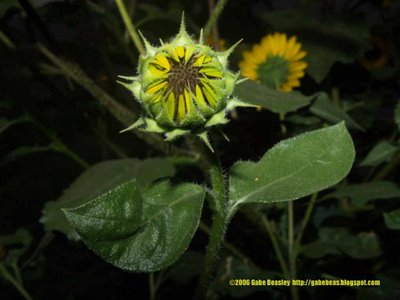 There are no intended insects in this shot.
There are no intended insects in this shot.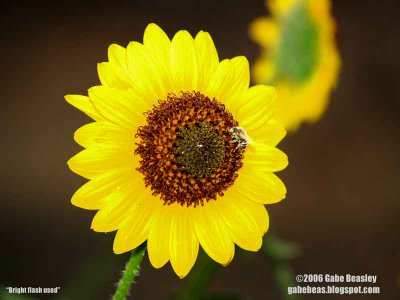 "Bully Bees"
"Bully Bees"I decided to photograph and document the actions of a small semi-large sweat bee new to myself and my photography in The Dalles. A local bee I have been tracking that I have dubbed the "bully bee" because of it's aggression towards it's own kind and other insects. But that aggression stops in a very bizarre way---as you will see. Some lucky shots have let me be able to actually prove it! The beetle and bee caught by my digital SLR right on time shows the attack in progress. Like a tackle in football--the bee body slams into it's victim and then falls with it nearly to the ground recovering. All of this sometimes in less then a second. Each it’s a game. In lighting speed it flies up to the flower it had targeted and removed the competition from and gut’s its' reward--only to possibly be toppled by another one of these gray robust bees. These are mostly all color-matched accurate files. Only the lady bug shots are off a big in white balance. Most of these shots were not taken with any Photoshop or other modifications accept a bit of levels here and there and pinning my auto-stamped name and Copyright. The greatest thing here is a was able to capture these actions as they happened. I have science right here. Showing this. I plan to study more as long as this incredible sunflower continues to attracted insects. Here is is--there are better pictures of this "bully bee" below--but it can be quickly picked out by how fuzzy it is. Especially in this overexposure. Click on picture for larger View.
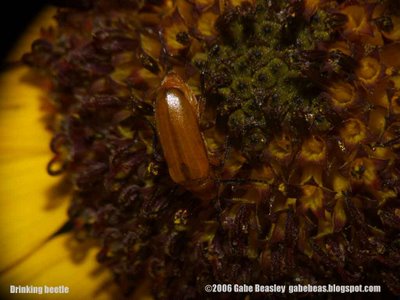 A beetle found often on sunflowers. You will see this poor guy get hit by an attack from a bully bee--looking!
A beetle found often on sunflowers. You will see this poor guy get hit by an attack from a bully bee--looking!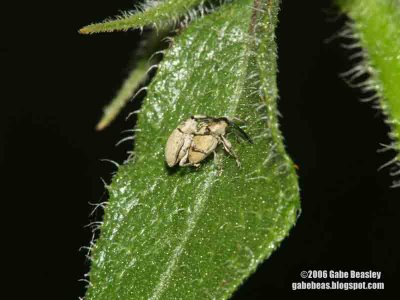 These tiny weaves are only about 2mm long. Probably the smallest beetles I have ever photographed.
These tiny weaves are only about 2mm long. Probably the smallest beetles I have ever photographed.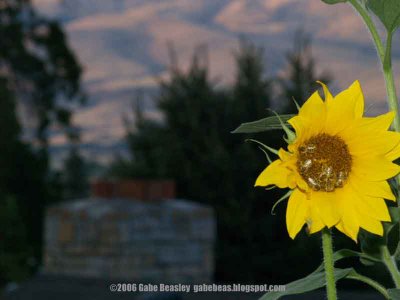
What's this? Keep looking at the pictures and see!
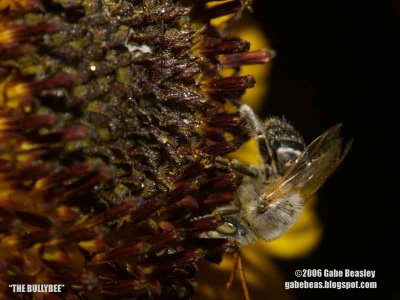
I HAVE NAMED THESE BEES "Bully bees" for how they treat there peers and other insects sometimes. IT SHOULD BE NOTED I made this name up myself because I can't find a name. It is one of 100s of species of bees called "sweat bees” I will tell get you the true name (if they have one) when and when I can. Until then they are just another kind of sweat bee. Many sweat bees exhibit similar behavior with there own kind. I have just not ever seen a species this aggressive, especially towards other insects.
I hope you enjoy these pictures as much as I do. To me flowers are usually a bit dull unless I win some points with the ladies with them! But they come alive when I see one with complex living insects on them. This combination is not only my favorite but also seems to sell me the most pictures. Flowers or green foliage pictures are everywhere--but good insect shots on them are not. I still photograph flowers alone, but they often need the incredible power they have over insects to be there greatest. I am fascinated by this ability flowers have to bring the incredible world of insects and spiders alive. I'm into bugs and photography of nearly all kinds now. So flower shots I have to ask my mom about. I am going to try to grow my own by next year. Simple ones that target insects and butterflies. It would be a great advantage to not have to risk trespassing, dogs and shotguns like I often do out here to get a good shot! The insect and thus spider possibilities have my blood pumping so much. So I think I will plant this garden for next spring and try to have some flowers of my own here more then just the regular weeds. I doubt they will live long because I deffinately don't have a green thumb but it can't hurt to try.
It's taken me over 14 hours of nearly non-stop work to bring you these pictures. It is ALLOT of work for me to get things right to be posted. I know--I write to much, but this compulsion is hard to control and I like to describe things. Very quickly this can get out of control and I forget to check all spelling and other things. PLEASE FORGIVE these errors. On average I am on line for 2 hours per picture.
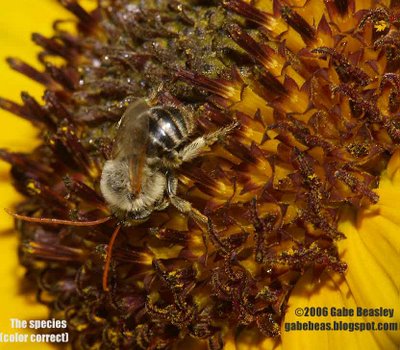 The "bully bee". At least that is what I call it now. See how fat she is, you will notice the clear difference between other sweat bees I photographed this year and last.
The "bully bee". At least that is what I call it now. See how fat she is, you will notice the clear difference between other sweat bees I photographed this year and last.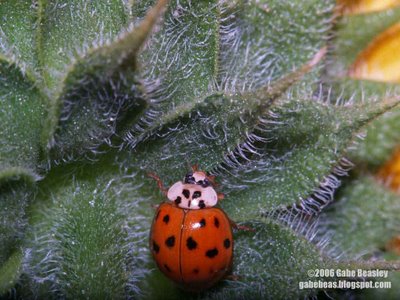 Ladybug walks on the underside of a bud.
Ladybug walks on the underside of a bud.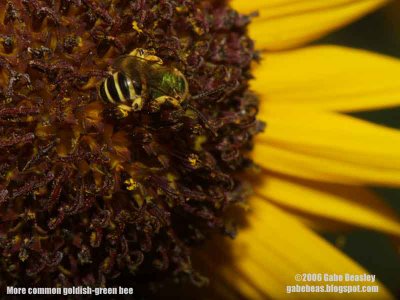 Here is one kind of sweat bee that I have seen compete by wrestling in the same way but only very rarely and for small flowers that are too large for two bees. So they are nothing in aggression like the "bully bees" as I have named them--which are clearly another species.
Here is one kind of sweat bee that I have seen compete by wrestling in the same way but only very rarely and for small flowers that are too large for two bees. So they are nothing in aggression like the "bully bees" as I have named them--which are clearly another species.
Another iridescent green-golden bee showing some size perspective. These are not typical huge sunflowers. They are not even as large as my outstretched hand. It will tolerate other occupants unless the flower is very small or very over crowded in which case this species attacks as well. Smashing into each other--I have a really good example of this on my wall. The "digital negative" is buried so deep in CDs I can't bring it back here without allot of work but if you go back in my website to last year you should find it in one of the summer months. Click for a slightly better view. USE < -- to get back to my website (your browsers back arrow)
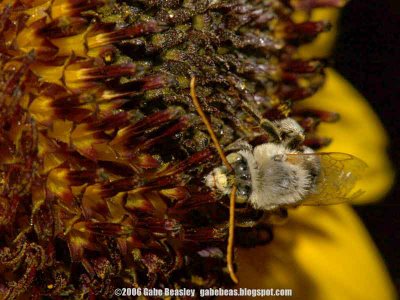 Here it is with that look "I’m going to kick your a--!" in it's eyes. These guys don't care how big the flower is---while buzzing around so fast I don't know how it can see anything, this one huge flower is not big enough for two of them. This one would be knocked down quickly if another one locked on to this flower. Face on--this high-macro shot is one of the best resolution shots I have. It is also definitely color correct. As most of my pictures are. I spend time to set my white balance right (usually).
Here it is with that look "I’m going to kick your a--!" in it's eyes. These guys don't care how big the flower is---while buzzing around so fast I don't know how it can see anything, this one huge flower is not big enough for two of them. This one would be knocked down quickly if another one locked on to this flower. Face on--this high-macro shot is one of the best resolution shots I have. It is also definitely color correct. As most of my pictures are. I spend time to set my white balance right (usually).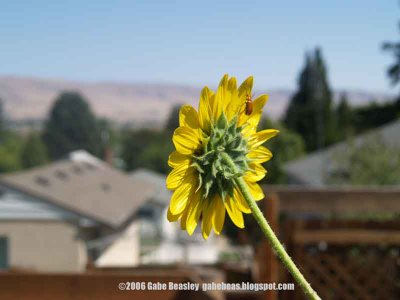 This is a view of the Hills over on the Washington Side. On the Sunflower, is a small red Beetle.
This is a view of the Hills over on the Washington Side. On the Sunflower, is a small red Beetle.Watch what happens to it.
 THE ATTACK!
THE ATTACK!The red beetle, shown in other pictures--as it is about to be knocked off the flower by this bee dive bomber. My observations show that they do not sting when they do this--but just use the force of there bodies. Incredibly they often get into fights as they fall down together (something I have not yet been able to photograph) but yet come out of it fine. A sting or bad bite from another bee would probably cause serious damage. I doubt they sting or even bite because this would be dangerous if not fatal to there own kind and a waste of valuable protein. And each one of these bees I have seen through my macro lens or photographed is not hurt or dammaged. No battle scars like the ones you seen other types of bees sometimes. Here is the next best frame I have pushing my digital SLR to it's limits--this is all completely over in I'd guess less then 1/2 second. This was even faster.

THE TACKLE and this is when it gets very exiting. These are the bees frames. This is the same picture of the same beetle and bee and the incident happened so quickly it takes a digital SLR to get the shot. As you can see the bee hits the beetle and seems to be grabbing it. The interesting thing about this attack is not that this flower has lots of space and the bee is being a true "jerk". It is very interesting that the beetle seems to be unharmed.
It landed on another flower and I watched and photographed it again. The same way when they attack each other. Since there are not dead beetles or bees on the ground here it seems they are normally do not use a sting or dangerous bites--it's more of a wrestling match. And they do not seem to attack other types of bees, probably because of the real danger they will not know this game and get hurt? I am just putting simple observations here. This is admittedly a very amateur study--but no less interesting.
 COUGHT IN THE TACKLE GAME
COUGHT IN THE TACKLE GAMEHere they are. In a moment captured by pure luck. The bee is comming in hot and fast--I had no idea and was only trying to get a shot of the single bee (the one on the flower) when at the exact moment at increible speed the tackle happened right in front of me! My shutter speed was very high. The attacking bee is marked with an arrow "The attack" This was cool--and I got a picture of it! You can see how the other bee is aimed at the one on the flower. This honestly was not camera skill--it was pure luck, and is nice proff of what I observed happening regularly. I still ask the question? Why do they do this?
Me having not seen them attack any other species of bee or wasp may just have been chance, but a venture a guess that the actions of tackling relitively harmless insects and the idea of going at it with another species of larger or even smaller more agressive bees--would cause them to look for warnings and not pick a fight with the wrong bug. For example--I never have seen them attack honey bees--honey bees are much larger. These bees are only 1/2 the size of a honey bee. And I never watched them hit smaller sweat bees which are easy to see by color are very different. They seem to be able to know at least for the most part what they are picking a fight with--but this is all pure amatur speculation.
This kind of bee seems to have to be "king of the flower" and unless in the state illitrated below, they will be very difficult to photograph. In the normal state of mind they will fly about drinking necktor for only about 2-10sec on each flower it goes to or steals from another bee, often until it gets toppled by another bee! And they spook at the first sign of me or a big camera. They seem to pick out flowers when they see thier own kind, or other insects like that beetle, and close in for the tackle. I still can't help but ask what for? Do they think that an occupied flower will have the best nektar? Or is it actually some kind of a game they play all day in the sun?
I find that impossible to beleave insects are playing games, but why would they do this only to turn completely dosile twards there own kind AND EVEN ME. It seems more a waste of energy to do these fights.
It is best to do short bursts of high-speed shots when you are close-at macro levesl this high, just a breeze can bring the subject out of focus. You can get 5 and then 10sec--and finally I got a shot like the few single-bee shots here at the moment before they takeoff. It takes ALLOT of effort and I have to be very sneeky about it when I photograph them as they go from flower to flower. Carefully approching them, litteraly not looking them in the eyes. Acting like a praying mantis. Being seemingly totally still and moving in close when they seem most distracted by the flower. I got less then a half dozen good shots out of nearly 100 of a single bee in the attack and active mode. I must have spent about a combined time of three to four hours there watching and taking pictures. On my last trip, Ready to walk away with some expected nice shots---on a gut-feeling I chose to look at the other plant and I found this! --this is the shock
of the year!
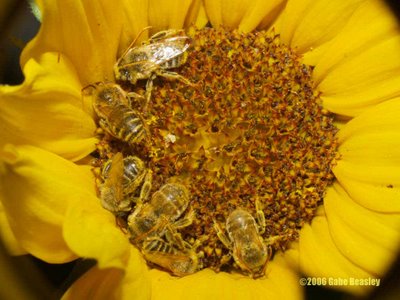
THE SAME BAD BEES! -First off, I know they are NOT mating or fighting or too cold. So with those things elinated then why do are they doing this!? Incredibly they become docile almost cuddly creatures quickly. Here seen covered in pollen. It is my guess that's because they are finished and full. Honey bees become docile under those conditions as well. Bee keepers use a smoker to get the bees to drink up there honey reserves leaving them almost drunk on sugars and thus far less aggressive. I theorize these bees are tired and getting some rest before taking flight to get to hives after feeding on the near by larger flower other larger sunflower bush.
If I recall, most sweat bees live in undergroud hives. They could be quite a long ways from home. Grouped together they are very passive and seemed not to notice me even when I got veryh close. Finding a couple of slightly secluded flowers like this shows more--they have a palce to hide in as these flowers were draped with dead folage and not easy to quickly see. Thier behavior completely changes. I observed and photographed them for at least another hour until sundown. Clearly as I say, they were not mating, or doing much of anything social except sitting there. The bee version of couch potatos.
Possibly they are drinking more nectar. Clearly they are part of a group of tolerations here I am nearly certain they were battleing eachother before this just as I documented but change when they get full or something. Honestly I need to look up more about how sweat bees usually live--but as I recall they are individually (like honeybees) unable to reproduce. Therefore they are all sterile-females and all from a hive with a queen or number of queens. I recall reading that they are less organized then honey bees but still follow some of the codes. Honey bees however to my knowledge--do not tackle each other like this except in the hive in rare deadly serious conditions.
You might think they are attacking bugs and bees because they are close to a hive--this is not probable as these pictures were not taken in a very good place for any kind of hives these bees could make. It is clear from other observations I made last year in another spot and where there are other sunflowers this year as well, that these "bully bees" keep up this kind of attitude no matter where the hive is. So it's not like hornets that attack everything alive to keep there hive safe. These bees are fighting each other but clearly stop and I'd bet that they are all from the same hive.
I've never seen this before let alone photographed it in action. I may never be able to get enough proof to say I photographed anything new or discovered a new behavior in sweat bees, I'm very sure I have not really found a new behavior. There are lots of qualified people who probably know all about this. And thus I am probably not the first to photographically document it, but sweat bee as "bullies" towards their own kind and even other insects and then being so paradoxically different later is if nothing else, a very interesting study in nature and photography. If given the chance, even in North America there are still countless insects and spiders we know little about. Any kind of study done is worth it especially to me. Learning how to observe and photograph animal behavior is one of my goals in photography. I am not limited to insects and spiders but they remain what I like to photograph the most.
 This is the spot. Behind my place there is a back road and the neighbors setup a big sunflower plant. I found even more in another plant just out of view closer to the van.
This is the spot. Behind my place there is a back road and the neighbors setup a big sunflower plant. I found even more in another plant just out of view closer to the van.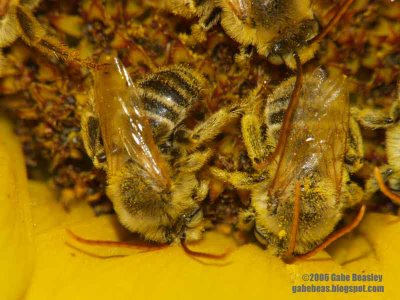 SNUG AS A BUG IN AH---FLOWER?
SNUG AS A BUG IN AH---FLOWER?Once aggressive enemies while dog-fighting from flower to flower--these usually very hard to shoot bees are side by side snug and also un-afraid of me while I got as close as 6 inches for this shot. The flower was filled. The wind was blowing which may have something to do with this puzzle as to why they chose to do this rather then compete on the other plant with only open flowers. One of these flowers offered some shelter. The other's did not. What makes them aggressive to such a "king of the hill" degree over there--and so passive and tolerant to each other now. One OTHER THEORY I have is that we are dealing with a male and female sunflower here. And that the large amount of pollen indicates a male sunflower which provides the bees far more nectar then the female plant while covering them in pollen. If this is true--then they may be drinking there full here and hitting up the female sunflower for nectar only. I don't have a book on plants---research is needed to prove any of these theories.
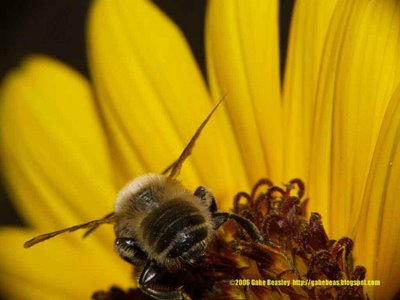 Here was a great shot. No, I'm not kidding. This clearly shows the serious differences between the iridescent greenish-yellow nearly golden bees and these fatter furrier species I call "bully bees". I'm going to have to find there proper name--but they may just be another sweat bee without one. Notice the difference in line patterns and hairs when you see the other bees on my website.
Here was a great shot. No, I'm not kidding. This clearly shows the serious differences between the iridescent greenish-yellow nearly golden bees and these fatter furrier species I call "bully bees". I'm going to have to find there proper name--but they may just be another sweat bee without one. Notice the difference in line patterns and hairs when you see the other bees on my website.
THIS is the other common sweat bee. A big brighter yellow then last year? Na--probably my color settings on my camera. This iridescent bee may be one of two very similar species or just the same. Honey bees can have different colorations in some cases to a small degree. These "races" of bees are common in other insects as well. Slight variations are very common so I can't be sure. This bee also will knock off competing sweat bees of it's own species, but it's not as aggressive and I have never seen it be as serious as the slightly fatter and furrier species. The one's I call "bully bees".
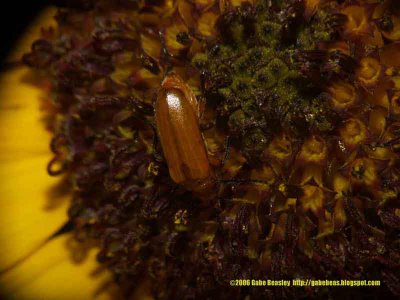 The beetle harmlessly drinking nectar. Like other bees--it's evicted quickly by the "bully bee" but not by the other sweat bees who don't seem to care.
The beetle harmlessly drinking nectar. Like other bees--it's evicted quickly by the "bully bee" but not by the other sweat bees who don't seem to care.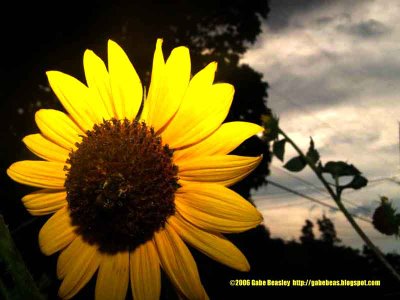 The sun goes down as I flash the flower very lightly. It's getting dark--are the bees going home like I am? I have many questions to answer. And a night vision video camera. Tonight?
The sun goes down as I flash the flower very lightly. It's getting dark--are the bees going home like I am? I have many questions to answer. And a night vision video camera. Tonight?I don't know---I've been up for about 3 days working on this--so forgive me if I made some errors in spelling and stuff here. Each block of text I have to run over to my word processor, spell-check it there--and then come back. The logger spell-check does not work on my system.
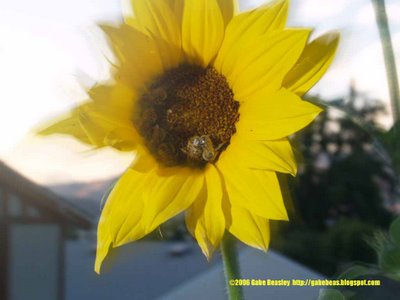 Some trick lighting created a new effect to know about. I have better examples for later posting.
Some trick lighting created a new effect to know about. I have better examples for later posting.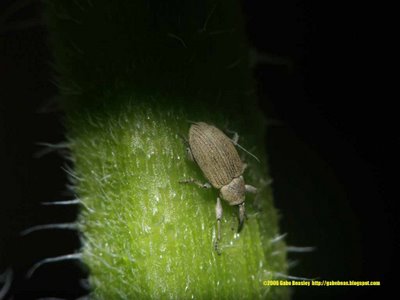 And a very small beetle, almost too small to see with the naked eye. I have allot of pictures to explain and show. Be sure to click on these for best view. This boll weevil is less then 2mm long.
And a very small beetle, almost too small to see with the naked eye. I have allot of pictures to explain and show. Be sure to click on these for best view. This boll weevil is less then 2mm long.
The weevils feed by pushing there long mouthparts like a trunk into the plants veins to drain it of fluids. I am proud of this shot and the rigging on my digital SLR that I came up with to make it possible. I weighted my digital SLR down with a L clamp and then a tripod mount so you can use your chin to further stabilize the picture. I might think about a patent for this idea--but I am certain most digital SLRs will soon have that vibration control rendering such heavy stuff obsolete if someone allready has not invented the thing.
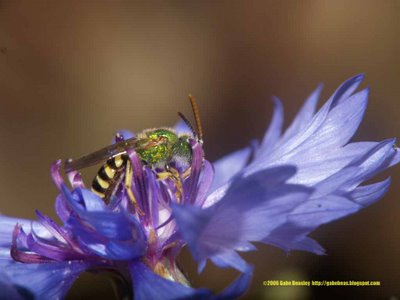 A typical green iridescent bee I shot yesterday.
A typical green iridescent bee I shot yesterday. A ladybug, just hanging out on the sunflower too.
A ladybug, just hanging out on the sunflower too.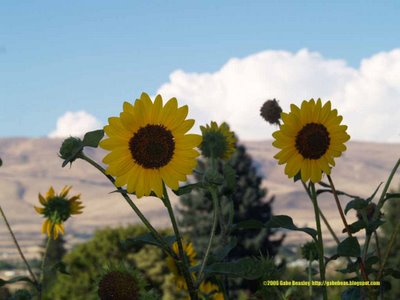 They are not that large. This picture makes them look bigger. They are only about as wide as my hand--even less. Not like the towering sunflowers we are all used too thinking about, and they all come up in the dozens form one plant.
They are not that large. This picture makes them look bigger. They are only about as wide as my hand--even less. Not like the towering sunflowers we are all used too thinking about, and they all come up in the dozens form one plant. Another iridescent bee--green-turned nearly golden by the pollen. Notice the colors--white and black. The size, and other things. The eyes give it away as a sweat bee--that is all.
Another iridescent bee--green-turned nearly golden by the pollen. Notice the colors--white and black. The size, and other things. The eyes give it away as a sweat bee--that is all.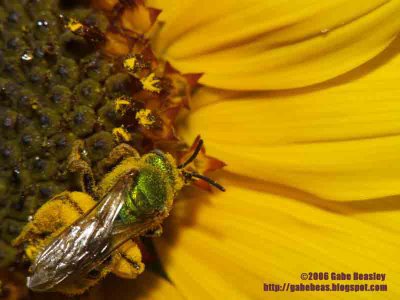 Notice the pollen sacks--this means this bee is definitely part of a hive. More on that later and can be found in my website back a few months.
Notice the pollen sacks--this means this bee is definitely part of a hive. More on that later and can be found in my website back a few months.
THE SAME BEES! - time of day AND they are NOT mating or fighting or too cold! Then why do are they doing this!? Incredibly they become docile almost cuddly creatures in hours. Here seen covered in pollen, probably because they are finished and full. Honey bees become docile under those conditions as well. Bee keepers use a smoker to get the bees to drink up there honey reserves leaving them almost drunk on sugars and thus far less aggressive. I theorize these bees are tired and getting some rest before taking flight to get home after feeding on the near by larger flower bush. Grouped together they are not as alert and thus not very afraid of me. Finding a couple of slightly secluded flowers like this to hide there behavior completely changes. I observed and photographed them for a few hours. Clearly as I say, they were not mating, or doing much of anything social except sitting there.
Possibly they are drinking more nectar. Clearly they are part of a group of toleration here. Honestly I need to look up more about how sweat bees usually live--but as I recall they are individually (like honeybees) unable to reproduce. Therefore they are all sterile-females and all from a hive with a queen or number of queens. I recall reading that they are less organized then honey bees but still follow some of the codes. Honey bees however to my knowledge--do not tackle each other like this.
You might think they are attacking bugs because they are close to a hive--this is not possible as where these pictures were taken is not a place for the kind of hives these bees make. (Often underground). It is clear from other observations I made last year in another spot and where there are other sunflowers this year as well, that these "bully bees" keep up this kind of attitude no matter where the hive is. So it's not like hornets that attack everything alive to keep there hive safe. These bees are fighting each other and likely all from the same hive.
I've never seen this before let alone photographed it in action. I may never be able to get enough proof to say I photographed anything new or discovered a new behavior in sweat bees, I'm very sure I have not really found a new behavior. And probably not the first to photographically document it, but sweat bee as "bullies" towards their own kind and even other insects and then being so paradoxically different later is if nothing else, a very interesting study in nature and photography.
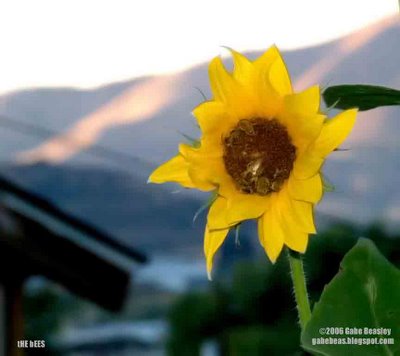 Now they settle in as I carefully adjust my lighting to the sun as it goes down. Will they spend the night here? That might be--since there are many bats that fly by night, I just might have to go back with my night-vision camera and find out if they do this to give themselves a rest and be ready to fly in the morning when bats are not around. It's 130am--walking around with a video camera in night-vision mode into this person's back yard might get me into more trouble then I can handle--so for now I will call this off. But I plan tomorrow to go and check this out. If they are still huddled--when the sun is down I will go with night vision on Hi8 tapes and find out if they are waiting or leave before sundown. This would be another peace to the puzzle.
Now they settle in as I carefully adjust my lighting to the sun as it goes down. Will they spend the night here? That might be--since there are many bats that fly by night, I just might have to go back with my night-vision camera and find out if they do this to give themselves a rest and be ready to fly in the morning when bats are not around. It's 130am--walking around with a video camera in night-vision mode into this person's back yard might get me into more trouble then I can handle--so for now I will call this off. But I plan tomorrow to go and check this out. If they are still huddled--when the sun is down I will go with night vision on Hi8 tapes and find out if they are waiting or leave before sundown. This would be another peace to the puzzle.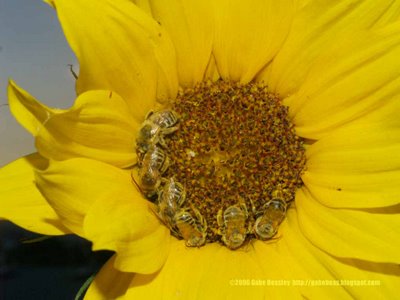 No matter how close I get they do not even notice me. When usually in order to capture a shot of a single bee--I have to be very quick and very patient. It often takes at least an hour to catch one. But when they are huddled--they seem to forget the outside world.
No matter how close I get they do not even notice me. When usually in order to capture a shot of a single bee--I have to be very quick and very patient. It often takes at least an hour to catch one. But when they are huddled--they seem to forget the outside world. Why are they out of the game? Wind is high enough, but the others are buzzing. Why are these one's hiding here? And why is there behavior and temperament so much less serious when in this state? Why do they swarm and attack other insects and almost certainly there own rivals of the same hive? And then drop that attack mode--and get along like this?
Why are they out of the game? Wind is high enough, but the others are buzzing. Why are these one's hiding here? And why is there behavior and temperament so much less serious when in this state? Why do they swarm and attack other insects and almost certainly there own rivals of the same hive? And then drop that attack mode--and get along like this?
Lighting changes don't matter.

Bee Donuts. Different lighting angles. As you can see they are pilled on top as if suckling from a mother. I have never seen anything like this in all my years of watching insects. And all this time I could have taken nearly perfect close ups here!
 Why are they out of the game? Wind is high enough, but the others are buzzing. Why are these one's hiding here? And why is there behavior and temperament so much less serious when in this state? Why do they swarm and attack other insects and almost certainly there own rivals of the same hive? And then drop that attack mode--and get along like this?
Why are they out of the game? Wind is high enough, but the others are buzzing. Why are these one's hiding here? And why is there behavior and temperament so much less serious when in this state? Why do they swarm and attack other insects and almost certainly there own rivals of the same hive? And then drop that attack mode--and get along like this? It is getting darker--but not colder. I have yet to go out at night and check because this is not exactly my yard and I have never met the owners. This was a tricky shot for lighting and ballencing depth of field.
It is getting darker--but not colder. I have yet to go out at night and check because this is not exactly my yard and I have never met the owners. This was a tricky shot for lighting and ballencing depth of field.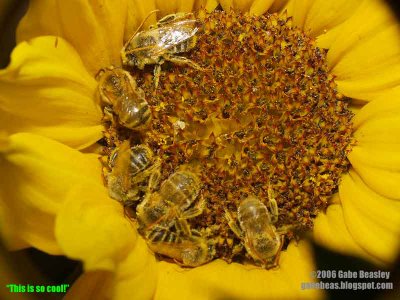 The communal huddle in a larger flower. Could there be something special about this flower or kind of Sunflower that produces this reaction?
The communal huddle in a larger flower. Could there be something special about this flower or kind of Sunflower that produces this reaction?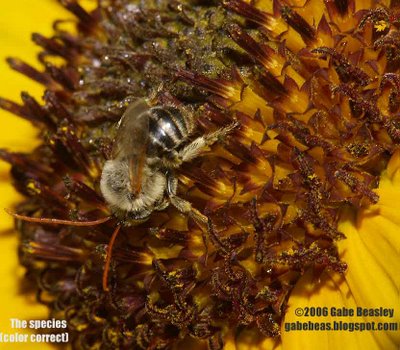 The loan fighter. Maybe it's just getting started. But she seems to delight in attacking everything else on that flower. Especially other bees of her kind. Notice how she's not covered with Pollen yet. This has led me to believe that the bees turned docile in groups like the ones above this picture are full and resting as where this one has just arrived.
The loan fighter. Maybe it's just getting started. But she seems to delight in attacking everything else on that flower. Especially other bees of her kind. Notice how she's not covered with Pollen yet. This has led me to believe that the bees turned docile in groups like the ones above this picture are full and resting as where this one has just arrived.
This is a lighting trick that sometimes just happens. In this case, I wanted to get the background lit and the bees in the flower as well. This is not a blended image, in fact, the only thing added or changed in this picture is my tiny (C) 2006 Gabe Beasley notice. This is an example of how an error can cause me to have to go to a great deal of trouble to fix. This time I will let it go. I got allot of work to do on my file system still and that is why I have not been posting pictures.
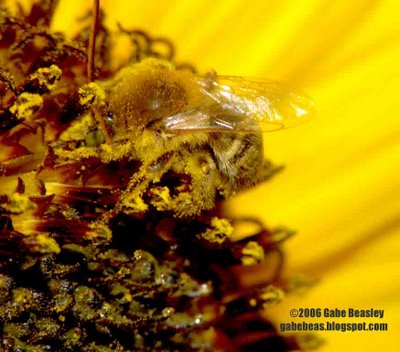 Here is a view of another one covered in polen. They are easy to tell from other sweat bees. The size of there abdomen and markings hold the key. These pint-sized sunflowers get most of the bees covered in polen until they nearly look as if they are in gold-dust. Incredible views made possible only by long waits. If I ever write a book on photography--the first rule I think I will put in it is the need for PASHENTS. I took a break and then tackled my database of pictures. 100s and 100s of CDs. I am glad I figured out a RAW + JPEG shooting mode that gets me what I want in my digital SLR.
Here is a view of another one covered in polen. They are easy to tell from other sweat bees. The size of there abdomen and markings hold the key. These pint-sized sunflowers get most of the bees covered in polen until they nearly look as if they are in gold-dust. Incredible views made possible only by long waits. If I ever write a book on photography--the first rule I think I will put in it is the need for PASHENTS. I took a break and then tackled my database of pictures. 100s and 100s of CDs. I am glad I figured out a RAW + JPEG shooting mode that gets me what I want in my digital SLR.THIS IS NOT THE END OF MY WEBSITE!
THERE ARE 100s MORE PICTURES TO SEE! MANY PEOPLE DON'T FIGURE THIS OUT. SEEING THE REST OF MY PICTURES HERE IS VERY SIMPLE, PLEASE READ HOW HERE!
Go to "all pictures" at the top of my website and click on each month starting with last month. Go up month by month and scroll down to the bottom until the very first month and you will have seen my entire website. I can't put 100s and 100s of pictures on one page or it would take days for even a fast computer to load my website. So I had to break it up into months. There are tons of pictures NOT ABOUT BUGS as well as articles. PLEASE DONT MISS IT--you will be glad you did not!
No comments:
Post a Comment